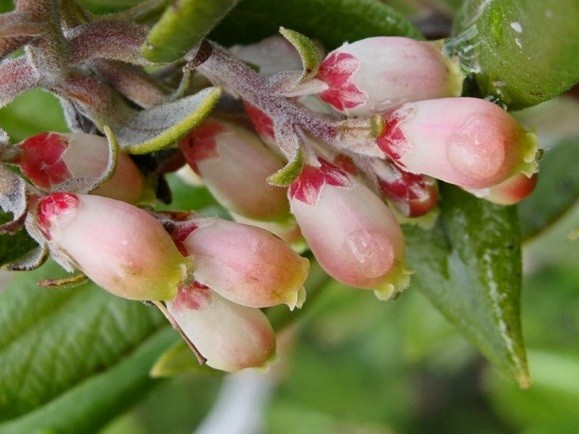Mission Manzanita
(Arctostaphylos bicolor)

Description
Xylococcus is a monotypic genus of flowering plants in the heather family which contains the single species Xylococcus bicolor, commonly known as the mission manzanita. It is a burl-forming, evergreen shrub to tree with leathery leaves and smooth dark reddish bark. From December to February, white to pink urn-shaped flowers adorn the foliage, often attracting hummingbird pollinators. It is native to southern California and the Baja California Peninsula, south to the Sierra de la Giganta. There is growing concern over the future of this plant, referred to as the "queen of the elfin forest, " as it may possibly lose up to 88% of its habitat and its wild seedlings are failing to survive more than a full year. Starting from the ground up, one will notice this evergreen shrub or tree has a burl, or lignotuber, an underground storage organ, which is topped by a smooth trunk with peeling red bark. The smooth red trunk is characteristic of other Arbutoideae in the region, like Arctostaphylos species, although this species has a darker tint to its bark. This species may rarely grow up to 6 metres (20 ft) in height. The stems are erect, generally less than 2.5 m (8.2 ft) in length, with canescent twigs. On the twigs are the alternately-arranged, leathery leaves, which have a lower surface that is densely covered with white to gray hairs. The margin of the leaves lack teeth and are rolled under. The leaves are up to 4.5 cm long. The dense inflorescence is a panicle, which hangs downward and is bracted. The pedicel is not jointed to the flower, with 2 bractlets. There are 5 sepals on the flower, along with 5 petals, which are fused to form an urn-shaped corolla. The white to pink corolla is covered in hairs. Within the flower, there are 10 stamens, with the filaments wooly in their lower half. The ovary is superior (attached to the receptacle above the attachment of other floral parts) and is hairy, with generally 5 chambers. Upon maturity, the flowers turn into a fruit around 9 mm (0.35 in) wide. The fruit is a dark-brown drupe, with 5 stones that are fused into a smooth unit. The plant's native range is very limited, to the Peninsular Ranges in Southern California (U.S.) and the Baja California Peninsula (México), the South Coast of California and Santa Catalina Island, and the northwestern Baja California coast and Cedros Island. Its populations are primarily in San Diego County, California and Baja California state.
Taxonomic tree:







